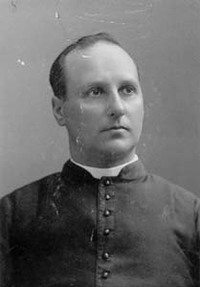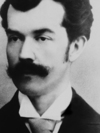
Source: Link
DE LAMARRE, ELZÉAR, Roman Catholic priest, professor, author, magazine editor, and founder of religious works; b. 8 Sept. 1854 in Sainte-Brigitte-de-Laval, Lower Canada, son of Charles De Lamarre, a sailor and then a farmer, and Luce Laroche; d. 21 April 1925 in Chicoutimi, Que.
The seventh of ten children, Elzéar De Lamarre grew up at Hébertville in the Lac-Saint-Jean region, where his parents had settled around 1858 to work a piece of land. Through the generosity of the local curé, who had noticed his intelligence, at the age of 16 he entered the Petit Séminaire de Québec, where he did his classical studies. As was often the case at the time, he went on in 1878 to the Grand Séminaire, choosing the one in Chicoutimi. There he began to study theology; he also acted as study master for the youngest pupils and taught versification and belles-lettres (the fourth and fifth forms), an indication of his intellectual ability. Ordained to the priesthood on 29 June 1883, he served for a number of years in parishes, including those of La Malbaie and Les Éboulements. In 1889 the new bishop of Chicoutimi, Louis-Nazaire Bégin, who wanted to staff the Séminaire de Chicoutimi with well-educated priests, sent him for further studies at the college of the Sacred Congregation of Propaganda in Rome, where he obtained a doctorate in theology in 1891. The Université Laval would also confer a similar degree on him in 1902.
On his return from Rome in 1891, Abbé De Lamarre took on assignments in teaching, staff training, group leadership, and administration at the Séminaire de Chicoutimi (both junior and senior levels). He was superior of the seminary from 1899 to 1905 and bursar from 1905 to 1908. Nonetheless, his name is mainly associated with the founding and development of pious and charitable works, some of which achieved notable success. Their guiding principle was devotion to St Anthony of Padua, which was doubtless the result of a pilgrimage that De Lamarre made to Padua, Italy, in 1891; its practice was strengthened by an active correspondence between the priest and the Italian proponent of that devotion, Canon Antonio Locatelli, with whom he had struck up a friendship during his stay in Rome. The Recollets had begun to arouse interest in the holy man of Padua among the Catholics of New France in the 18th century. Orders and congregations of the Franciscan family had kept it alive until there was a new surge in the popularity of the devotion at the time of the Catholic religious reawakening in Quebec in the second half of the 19th century. The promotion of ultramontane piety and the expansion of popular devotions infused with intense emotionalism were part of the wider context within which De Lamarre carried on his work.
Thanks to De Lamarre’s energetic efforts, the promotion of the veneration of St Anthony grew spectacularly in the 1880s and 1890s. In 1894 he founded an orphanage for girls which was known as the Orphelinat Saint-Antoine. The Augustines de la Miséricorde de Jésus (Augustinian nuns) agreed to take charge of it at the Hôtel-Dieu Saint-Vallier in Chicoutimi. He immediately linked it with the Œuvre du Pain de Saint Antoine, whose purpose was to ensure financial support for the orphanage. In the same year he brought out in Chicoutimi La dévotion à saint Antoine de Padoue, which went through several editions including an English one by 1895. In June 1895 he and Abbé Victor-Alphonse Huard launched Le Messager de Saint-Antoine, of which he would be the guiding spirit for 30 years. In a general way, the magazine sought to educate readers in prayer and reliance on God in daily life, as well as to develop the practice of Christian virtues. More specifically, its aim was to promote the devotion to St Anthony and to support De Lamarre’s charitable works. Each monthly issue contained an editorial that for the most part dealt with religious matters, articles reprinted from other magazines, an episode from the life of St Anthony, news about the church, personal witnessing, lists of favours sought and obtained, accounts of miracles, and announcements. It also progressively became an instrument for promoting devotion to the Virgin Mary. With more than 10,000 copies printed for each issue during the first decade of the 20th century, there were readers in Canada and the eastern United States. In January 1896 De Lamarre launched St Anthony’s Canadian Messenger, an English version of Le Messager, which was published until December 1903. While he was superior, De Lamarre in 1904 founded a religious community for women, the Sœurs de Saint-Antoine de Padoue, which was made responsible for the maintenance of the Séminaire de Chicoutimi. He also drafted the first constitution and rules for this congregation, which would adopt the name of Sœurs Antoniennes de Marie, Reine du Clergé, in 1929.
In 1907 De Lamarre bought a property on Lac Bouchette, south of Lac Saint-Jean, and had a house and chapel built there, where he could relax. (The chapel would be decorated by his cousin, the painter Charles Huot.) The Ermitage San’Tonio, as he called it, soon became a regional centre for pilgrimages to Notre-Dame de Lourdes. One day while out walking, De Lamarre had discovered a cave similar to the one at Lourdes, in France, and he had a statue of the Virgin Mary set up in it. People from the surrounding area went there to pray; after testimonies were given about favours received as a result of visiting the site, the number of visitors continued to increase. In 1922 a 50-room inn was built to accommodate the pilgrims.
De Lamarre also helped make the place popular through his commitment to spreading the devotion to St Anthony. For instance, he was North American director of the Universal Association of St Anthony of Padua from 1895 to 1925, a period during which he paid particular attention to dedicating children to the saint. In 1920 he published in Montreal the Manuel du pèlerin. Meanwhile, thanks to Le Messager, various religious and votive forms (miraculous responses, novenas, the month of St Anthony) were being introduced among the faithful, who came in ever-increasing numbers to the hermitage.
Like many priests of his day, De Lamarre took great pleasure in writing, a pleasure manifest in his religious writings, of course, but also in other forms. In 1892, for instance, he was one of the founders of L’Oiseau-mouche, the college newspaper of the Petit Séminaire de Chicoutimi, for which he wrote under the pseudonym of Livius. In 1924, under the name of C. de La Roche, he brought out at Quebec a work about his nephew Victor De Lamarre*, Victor De Lamarre, le roi de l’haltère. He was also the author of Ad limina apostolorum, a symphonic ode composed in 1883 to welcome Bishop Dominique Racine* of Chicoutimi on his return from Rome. It was set to music by Abbé David-Odilon Dufresne.
A man of many talents, Abbé Elzéar De Lamarre seems to have been rather unassuming and conciliatory by nature. The records show only one case where he was at odds with the diocesan authorities. The difference of opinion occurred near the end of his life, with Bishop Michel-Thomas Labrecque*, on the question of transferring the sanctuary at Lac Bouchette to the Capuchins rather than to the diocesan church in Chicoutimi. The priest had had difficulty finding a religious congregation willing to carry on his work, probably because of the sanctuary’s burden of debt. The bishop of Chicoutimi finally gave in to De Lamarre’s last wishes, and on 21 Oct. 1925 the Capuchins became the owners of the sanctuary and of Le Messager de Saint-Antoine. Both of these endeavours are thriving today, as are the Œuvre du Pain and the Sœurs Antoniennes de Marie; all of them keep alive the memory of a priest considered a “holy man.”
Much information concerning Father De Lamarre and his works is available at the Arch. du Diocèse de Chicoutimi, Qué., and the Arch. des Sœurs Antoniennes de Marie, Chicoutimi.
ANQ-Q, CE301-S27, 10 sept. 1854. Le Progrès du Saguenay (Chicoutimi), 23 avril 1925. Antonio Dragon, L’abbé Delamarre, fondateur des Sœurs antoniennes de Marie et des pèlerinages du Lac Bouchette ([Chicoutimi], 1974). Évocations et témoignages: centenaire du diocèse de Chicoutimi, 1878–1978 (Chicoutimi, 1978). Louise Gagnon-Arguin, “La dévotion à Saint-Antoine à travers le Messager de Saint-Antoine; essai d’analyse d’une dévotion populaire” (mémoire de ma, univ. Laval, Québec, 1978). André Simard, Les évêques et les prêtres séculiers au diocèse de Chicoutimi, 1878–1968; notices biographiques (Chicoutimi, 1969), 93–95. Laurent Tremblay, Au service du royaume; spiritualité de l’abbé De Lamarre (Chicoutimi, 1979).
© 2005–2024 University of Toronto/Université Laval
Image Gallery

Cite This Article
Claude Gilbert, “DE LAMARRE, ELZÉAR,” in Dictionary of Canadian Biography, vol. 15, University of Toronto/Université Laval, 2003–, accessed April 15, 2024, http://www.biographi.ca/en/bio/de_lamarre_elzear_15E.html.
The citation above shows the format for footnotes and endnotes according to the Chicago manual of style (16th edition). Information to be used in other citation formats:
| Permalink: | http://www.biographi.ca/en/bio/de_lamarre_elzear_15E.html |
| Author of Article: | Claude Gilbert |
| Title of Article: | DE LAMARRE, ELZÉAR |
| Publication Name: | Dictionary of Canadian Biography, vol. 15 |
| Publisher: | University of Toronto/Université Laval |
| Year of publication: | 2005 |
| Year of revision: | 2005 |
| Access Date: | April 15, 2024 |











